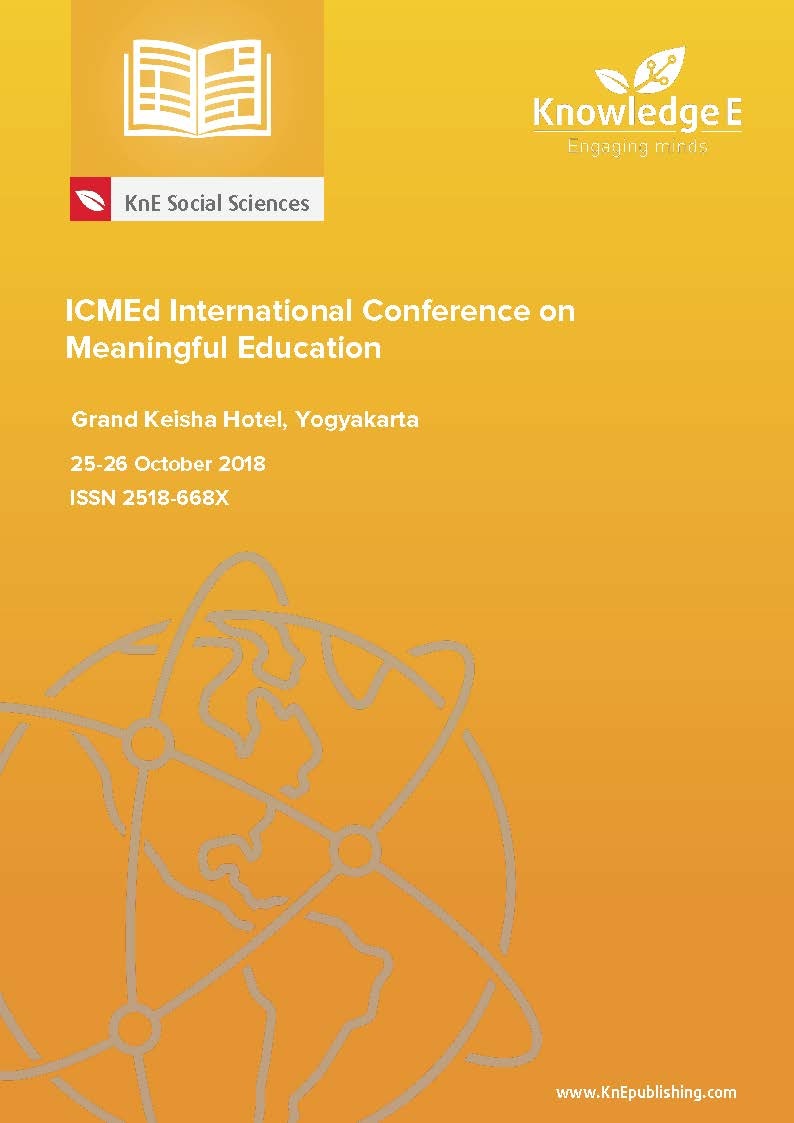Development of Maquette to Promote Primary School Students’ Critical Thinking Ability in Social Sciences
DOI:
https://doi.org/10.18502/kss.v3i17.4680Abstract
This research aimed to analyse the feasibility of the use of maquette and the effectiveness of maquette in improving students’ critical thinking ability. The research model employed was the development research model developed by Borg & Gall. The research subjects were third graders. The testing was divided into preliminary field testing, main field testing, and operational field testing. The analysis of the medium feasibility was based on the assessment by media experts, the assessment by subject matter experts, students’ response, and teacher’s response. The analysis of maquette effectiveness was carried out using a t-test (two independent samples) to figure out the difference and gain score of the experimental class for the purpose of identifying the improvement after the use of maquette. In the feasibility analysis, a score of 88 in the category “feasible” was gained from the assessment by a media expert and a score of 85 in the category “highly feasible” was gained from the assessment by a subject matter expert. From the preliminary field testing, scores of 60.5 and 65 in the category “highly feasible” were gained for the students’ response and teacher’s response, respectively. Meanwhile, from the main field testing, scores of 56.1 and 66.5 in the category “highly feasible” were gained for the students’ response and teacher’s response to the maquette use, respectively. The t-test results show a significant value in the critical thinking, namely.000 <.05, indicating a significant difference between the control class and the experimental class. The gain score was 0.5 and fell into the “moderate” category. Thus, it can be concluded that maquette is effective in improving critical thinking ability.
Keywords: maquette, critical thinking ability, social sciences learning
References
Abrami, P.C., Robert M.B., et al., “Instructional Interventions Affecting Critical Thinking Skills and Dispositions: A Stage 1 Meta-Analysis”, Review of Educational Research: America Educational Research Association (2008)
Abdelraheem, Ahmed Yousif., and Ahmed Hamed Al-Rabane., “Utilisation and Benefits of Instructional Media in Teaching Social Studies Courses as Perceived by Omani Students,” Malaysian Online Journal of Instructional Technology 2(1), 1-8 (2005).
Brookfield, Stephen.D. “Teaching For Critical Thinking Tools and Techniques to Help Students Question Their Assumptions,” San Fransisco: Jossey-Bass, 2012
Chapin, June. R., “A Practical Guide To Middle And Secondary Social Studies Third Edition,” Boston: Pearson, 2011.
Dwyer, C.P., Michael J.H., Ian S., “An Integrated Critical Thinking Framework for the 21st Century”, Thinking Skills and Creativity, 12, 43-51 (2014).
Halpern, Diane F., “Teaching for Critical Thinking:Helping College Students Develop the Skills and Dispositions of a Critical Thinker,” New directions for teaching and learning, Jossey-Bass Publishers, 1999.
Hasnunidah, Neni.,”Keterampilan Berpikir Kritis Siswa SMP Pada Pembelajaran Ekosistem Berbasis Konstruktivisme Menggunakan Media Maket”, Universitas Lampung: Jurnal Pendidikan MIPA. Vol 3 No 1, 64-74, 2012
Heinich, Robert., Michael Molenda.,et.al., “Instructional Media and Technologies for Learning (seventh edition)”, Ohio: Merrill Prentice Hall, 1985.
Johnson, R.Burke., L.Christensen.,”Educational Research Quantitative, Qualitative, and Mixed Approaches 5
Kamarulzaman, Wirawani binti., Ismail Sheikh bin Ahmad., “Contributing factors to children’s critical thinking ability: The perception of pre-service teachers from a private University in malaysia”, Southeast Asia Psychology Journal, 2, 69-76 (2014).
Lai, Emily R., “Critical Thinking: A Literature Review Research Report”, Pearson, 2011.
Marin, Lisa.M., Diane F.Halpern., “Pedagogy for Developing Critical Thinking in Adolescents: Explicit Instruction Produces Greatest Gains”, Thinking Skill and Creativity, 6(1), 1-13 (2011).
Munadi, Yudhi.,”Media Pembelajaran (Sebuah Pendekatan Baru)”, Jakarta: Referensi, 2013
November, N.,”Using Social Media to Enhance Critical Thinking: Crossing SocioEducational Divides”, Palgrave Macmillan, DOI 10.1007/978-1-137-37805-7, ISBN 978- 1-349-47812-5 ISBN 978-1-137-37805-7, (2015)
Prastowo, A., “Panduan kreatif membuat bahan inovatif”. Jogjakarta: Diva, 2012.
Santrock, John. W., “Educational Psychology. Singapore”, mcGraw-Hill, 2011.
Smaldino. Lowther. Rusell., “Instructional Technology and Media for Learning”, United States of America: Pearson, 2014.
Soulier, Steven., “The Instructional Media Library:Real Objects and Models”, United States of America: New Jersey, 1981.
Wati, Ega Rima., “Ragam Media Pembelajaran Visual-Audio Visual-Komputer Power Point-Internet-Interactive Video”, Yogyakarta: Kata Pena, 2016.
Yin, Li., “Integrating 3D Visualization and GIS in Planning Education”, Journal of Geography in Higher Education 34(3), 419-438 (2010).

